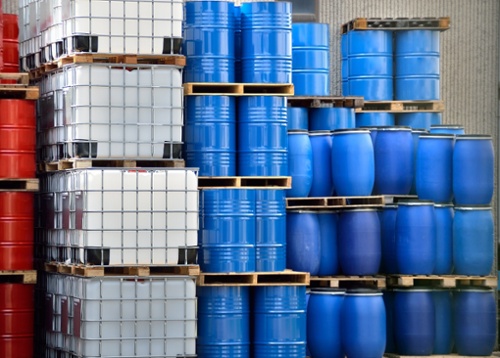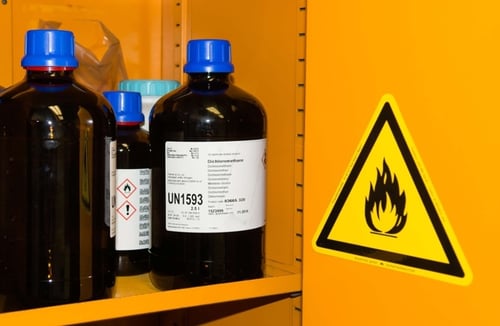Many hazardous chemicals and dangerous goods have incompatibility hazards. An incompatibility hazard is the potential for incompatible substances (which encounter one another) to create a dangerous reaction. Fires, explosions, or the release of toxic, corrosive or flammable vapours, are all dangerous reactions that can be caused by the mixing of incompatible chemicals. To help with your hazard identification and risk assessment process, this post looks at different factors which influence chemical compatibility.
What is an Incompatible Chemical?
Incompatible chemicals are defined in the Australian Standard as dangerous goods (or other goods) that are:
- Likely to interact with the dangerous goods, increasing the hazard when mixed or brought into contact; or
- Listed in the Australian Dangerous Goods Code as being incompatible; or
- Declared by the regulatory authority to be incompatible.
Examples of chemicals that are incompatible are too many to mention, however, commonly found dangerous goods, such as flammable liquids, are incompatible with most other classes including (but not limited to) Class 2 Gases, Class 4 Flammable Solids, Class 5.1 Oxidising Agents, Class 6 Toxic Substances and Class 8 Corrosive Substances.
Incompatible materials meaning is also found in the Standard. It explains that, when looking at other items (such as containers or storage equipment), an incompatibility is the interaction of the chemical with the material, causing damage or weakening the item. Incompatible products are chemicals that may interact dangerously with other goods found in the workplace, such as spill kit absorbents, chemical bunding or containers, such as drums, bottles or jars.
Identifying Chemical Incompatability
In the next section of our post, we’ll be looking at ways to recognise incompatibility hazards in your chemicals stores. Through the highlighting of real-world examples, we’ll help you understand how to idenfity incompabilities that may exist in your workplace.
We’ll be discussing 3 key areas for concern, including:
- Incompatible mixtures
- Incompatible containers
- Incompatible storage arrangements
Incompatible Mixtures
The first type of incompatibility hazard occurs when incompatible substances contact one another, when either deliberately mixed by a worker or during a spill.
Chemicals Mixed By Workers
When workers mix two or more highly reactive chemicals together in error the result can be a catastrophic fire, explosion or release of toxic gases. Many workplace accidents and dangerous incidents occur when workers don’t understand incompatibility hazards or when substances haven’t been labelled or stored correctly. This is certainly true in the example below, could this happen at your workplace?

Many chemical classes are incompatible and must be kept separate to maintain safety.
REAL WORLD EXAMPLE: Two containers of chemicals at a water treatment plant were stored next to one another. One drum contained the chemical sodium bisulfate and in the other, sodium hypochlorite (a type of bleach). These two substances are incompatible. A group of workers noticed the sodium bisulfate drum needed filling. By mistake, one worker began filling the bisulfate drum with bleach, causing a violent reaction. The chemical drum ruptured and sprayed two workers with chemicals as well as releasing dangerous gases. Two workers received severe chemical burns and respiratory complications, three more (who helped decontaminate the area) were treated for respiratory difficulties.
Chemical Hazards Created During Spillage or Disposal
When two or more incompatible hazardous substances are spilled or mixed-up during waste disposal, they may produce flammable, toxic or corrosive gases/vapours.
Chemical reactions like this can occur very quickly, but in many instances, it takes a long time for the build-up of hazardous materials to create an emergency. Your risk assessment must always consider the way you dispose of hazardous waste.
REAL WORLD EXAMPLE: Workers required medical treatment for headaches, burning eyes, and chest pains when they were exposed to fumes coming up from a floor drain. A chemical reaction between sulphuric acid and photographic chemicals that had been poured down the drain created the dangerous fumes.
Need to segregate incompatible chemicals?
Incompatible Containers
Many incompatibility hazards occur because of the container used to store the chemicals. Sometimes the containers or cabinets themselves are not suited to the hazard class of the chemical, at other times the container fails and the hazardous chemicals inside are released.
Chemicals Stored in Unsuitable Containers
When carrying out your chemical hazard analysis and risk assessment you should pay close attention to the suitability of the containers and safety cabinets holding each of the substances. Use only containers constructed in full conformance with the Australian Standards and purpose-built for the hazard class of the chemical being stored. Avoid using makeshift cupboards and mixing vessels because it can be almost impossible to determine the chemical properties of the building materials and componentry.
REAL WORLD EXAMPLE: A worker was mixing cement in a waste ceramic shell. The worker didn’t realise the ceramic shell had been constructed using thorium oxide, which reacted with the cement as water was being added. The mixture became hot and began to release smoke and a fume of sulphuric acid. Approximately 9 workers were exposed to the fumes, with some of them suffering irritation to the respiratory tract and lungs.
Containment Structures Degrading Over Time
Hazardous chemicals (particularly corrosives) will eventually degrade chemical safety cabinets and containment vessels.

Inspecting and maintaining all of your workplace chemical storage equipment will help you ensure safety and compliance.
Your risk assessment should always factor in the guaranteed lifetime of all containers, compounds, and chemical storage cabinets.
REAL WORLD EXAMPLE: A steel process tank at a manufacturing plant collapsed and caused catastrophic damage on two adjacent worksites. On one of the worksites employees were injured and property was damaged, at the other worksite a customer was killed. A chemical manufacturing process involving sodium hydroxide was being carried out in a high-strength steel tank, but the materials in the coating used to protect the process tank from the corrosive chemicals had never been sufficiently tested for suitability. The coating eventually failed which led to stress corrosion and cracking in the tank. The tank collapsed violently, destroying the exterior building and propelling debris onto the two adjacent worksites.
Spilled Chemicals Damaging Other Chemical Containers
During your risk assessment you should consider if an accidental release of hazardous substances could damage or destroy the packaging materials or containers of other chemicals. This is a critical consideration if there is any chance of a corrosive chemical being released or spilled.
Incompatible Storage Arrangements
Another type of incompatibility hazard is when hazardous substances are stored too close to flammable materials. Any resulting fire will be intensified by the chemicals or will set off other dangerous reactions.
Fire Releases Chemicals into the Environment
When flammable or oxidising chemicals are stored next to toxic and corrosive substances, a fire in the area could cause the rapid dispersal of toxic gases and corrosives. A risk assessment should consider how work operations like load packaged chemicals and warehouse transfers could impact other substances stored nearby.
REAL WORLD EXAMPLE: A fire broke out at a chemical warehouse when packages of oxidisers being transferred by forklift were dropped and ignited. The fire damaged chemical stores which released chlorine gas and fire fighters were exposed to the toxic fumes.
Fire/Dangerous Reaction with Chemical Containers
Consider the possibility of fires or other dangerous reactions damaging your chemical stores. You may need to ensure hazardous chemicals like compressed gases or aerosols are stored in cages with sufficient projectile protection, or liquid chemical containers have enough spill protection.
REAL WORLD EXAMPLE: A fire broke out on an upper-level grate floor, this also caused an explosion. A chemical tank turned over during the explosion and spilled over an employee working on the floor directly below the grate. He was killed, and 2 other employees (who tried to help their co-worker) were hospitalised after exposure to chemical vapours.
Incompatible Fire Extinguishers
Even fire extinguishers can create incompatibility hazards. Suppression equipment installed to provide fire protection for one substance, may be incompatible with another chemical stored in the same area. Your risk assessment should carefully consider the chemical properties of the fire suppression foams and powders you have at the workplace.
Safe Storage of Incompatible Chemicals
As we’ve highlighted in this post, an incompatibility within a chemical store can result in a reaction or hazard being created. Incompatibilities must be identified and controlled to ensure compliance and safety, with every substance, chemical container and storage area assessed for risk. And while we’ve illustrated some incompatibilities that may be found onsite, there are many more scenarios to consider.
Due to the complexity of incompatibility hazards, we strongly recommend that you conduct a full risk assessment onsite. Our free eBook How to manage the risk of Hazardous Chemicals in the workplace is a helpful resource for businesses carrying dangerous goods and hazardous chemicals, as it explains how to properly identify, assess, and control chemical risks and incompatibility hazards. Get your copy today and create a safer and more compliant work environment for your team.
Joining the team as a Dangerous Goods Storage Consultant, Melissa Hampton became Storemasta's Marketing Manager in late 2021. With extensive knowledge and experience in chemical compliance, Melissa is responsible for leading the Marketing team and helping shape their marketing strategy. In her spare time, you can find Melissa hiking, swimming and enjoying the great outdoors in beautiful north-west Tasmania.
